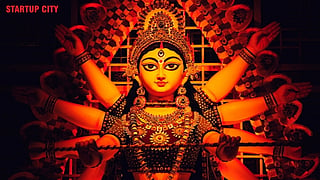
Navratri 2024 is almost here, starting on Tuesday, April 9, 2024, and lasting for nine special days until April 17, 2024. During this time, Hindus all over India celebrate with a lot of excitement and dedication. Navratri means 'nine nights' in Sanskrit and is a time to honour Goddess Durga and her nine different forms.
प्रथमं शैलपुत्री च द्वितीयं ब्रह्मचारिणी।
तृतीयं चन्द्रघण्टेति कूष्माण्डेति चतुर्थकम् ।।
पंचमं स्कन्दमातेति षष्ठं कात्यायनीति च।
सप्तमं कालरात्रीति महागौरीति चाष्टमम् ।।
नवमं सिद्धिदात्री च नवदुर्गा: प्रकीर्तिता:।
उक्तान्येतानि नामानि ब्रह्मणैव महात्मना ।।
For those curious about which forms of Goddess Durga is worshipped on each day, the following list provides clarity:
During Navratri, Hindus honour the nine forms of Goddess Durga, known as Navadurga. The first form is Maa Shailputri, representing the highest state of consciousness. Maa Shailputri is believed to be the daughter of the mountain, symbolising intense experiences or emotions.
Mantra: We can worship Maa Shailputri by chanting the mantra "ॐ ऐं ह्रीं क्लीं शैलपुत्र्यै नम:".
On the first day of Navratri, wear white clothes as it represent the specific qualities of the goddess.
Maa Brahmacharini, the second form of Nav Durga, symbolises the infinite and omnipresent. "Brahma" denotes boundless, supreme consciousness. Meditation leads to an experience where energy peaks and one feels united with the divine. Maa Brahmacharini represents dynamic consciousness, transcending limitations.
Mantra: Chant the mantra "ॐ ऐं ह्रीं क्लीं ब्रह्मचारिण्यै नमः" to worship Maa Brahmacharini.
On the second day of Navratri, wearing red represents action and power, symbolising the fierce aspect of the goddess.
Maa Chandraghanta, the most admired third form of the Divine Mother, symbolises inner peace and tranquillity. The term "Chandraghanta" derives from "Chandra," representing our fluctuating emotions, and "Ghanta," akin to a temple bell that resonates a uniform sound amidst the chaos. Invoking Maa Chandraghanta aligns our scattered minds with divine serenity.
Mantra: Chant the mantra "ॐ ऐं ह्रीं क्लीं चन्द्रघंटायै नम:" to worship Maa Chandraghanta.
Wear Royal blue colour clothes on the third day as it represents the peace and depth of the deep blue sky.
Maa Kushmanda, the fourth form of the Divine Mother, embodies vitality and energy. "Kushmanda" translates to "pumpkin" in Sanskrit, representing the energy that pervades the universe. In ancient tradition, only Brahmins and wise individuals consumed pumpkin due to its believed advantages in enhancing vitality and intellect. Pumpkin is known to absorb and emit vital energy, reflecting the expansive nature of consciousness within the cosmos. Reflecting on oneself as a pumpkin represents aligning with Maa Kushmanda's omnipresent vitality.
Mantra: By chanting mantra "ॐ ऐं ह्रीं क्लीं चामुण्डायै नम:" we can worship Maa Kushmanda on the fourth day.
Wear yellow clothes on Navratri's fourth day as it symbolises joy and victory, traits of the divine mother.
Maa Skandamata, the fifth form of the Divine Mother, symbolises intellect and action. Derived from Lord Kartikeya, "Skanda" signifies the blend of wisdom and action. Skandamata brings practical knowledge to life, turning it into action. She represents the combination of Shiva's calm essence and the energy of the goddess, responsible for deeds.
Mantra: Chant mantra "ॐ ऐं ह्रीं क्लीं स्कंदमातायै नम:" to worship Maa Skandamata on the 5th day.
Wear Green colour clothes on the fifth day of the Navratri as it represents growth and prosperity.
Not everything in our universe is visible. There's a vast, unseen world beyond our senses, governed by Goddess Katyayani. She showcases the divine force behind the invisible and unexpressed world. Maa Katyayani represents both the positive and negative aspects of anger. When fueled by wisdom, anger becomes a tool for righteousness. Natural disasters, often seen as nature's fury, are connected to her divine form. She signifies the destruction of negativity and the establishment of positivity.
Mantra: By Chanting the mantra "ॐ क्रीं कात्यायनी क्रीं नम:" on the 6th day of Navratri we can worship Maa Katyayani.
Wear Slate- coloured clothes on the sixth day of the Navratri as it represents the balance in life.
The seventh form of Goddess Durga is Maa Kalaratri, representing her most terrifying and fierce aspect. Yet, even in this form, she is dedicated to motherhood. She provides us with wisdom and helps us let go of things we don't need.
Mantra: Chant mantra "ॐ ऐं ह्रीं क्लीं कालरात्र्यै नम:" to worship Maa Kalaratri on the seventh day of Navratri.
Wear Orange coloured clothes on the seventh day as it represents the brightness and energy of the sun.
Maa Mahagauri, the eighth form of the Mother Goddess, symbolises pure beauty and grace. She's calm and caring, blessing everyone with her love. When we meditate, we feel her gentle presence, beyond what we see. People in both Hinduism and Buddhism respect her, as she awakens our inner peace and spirit.
Mantra: By Chanting mantra "ॐ ऐं ह्रीं क्लीं महागौर्ये नम" ,we can worship Maa Mahagauri on the 8th day.
Wear Peacock Green colour on the 8th day as it represents uniqueness and individuality.
Maa Siddhidatri is the ninth form of the Divine Mother. She blesses us with progress and fulfils our desires. She grants achievements and abilities, bringing perfection to every aspect of our lives. Maa Siddhidatri symbolises the fulfilment of wishes even before they are expressed.
Mantra: By Chanting mantra "ॐ ऐं ह्रीं क्लीं सिद्धिदात्र्यै नम" we can worship Maa Siddhidatri on the ninth day.
Wear Pink coloured clothes on the ninth day of Navratri, as it represents love, affection and unity.
So, let's mark our calendars and join in the festivities to honour and take the blessings of the divine goddess during Navratr!